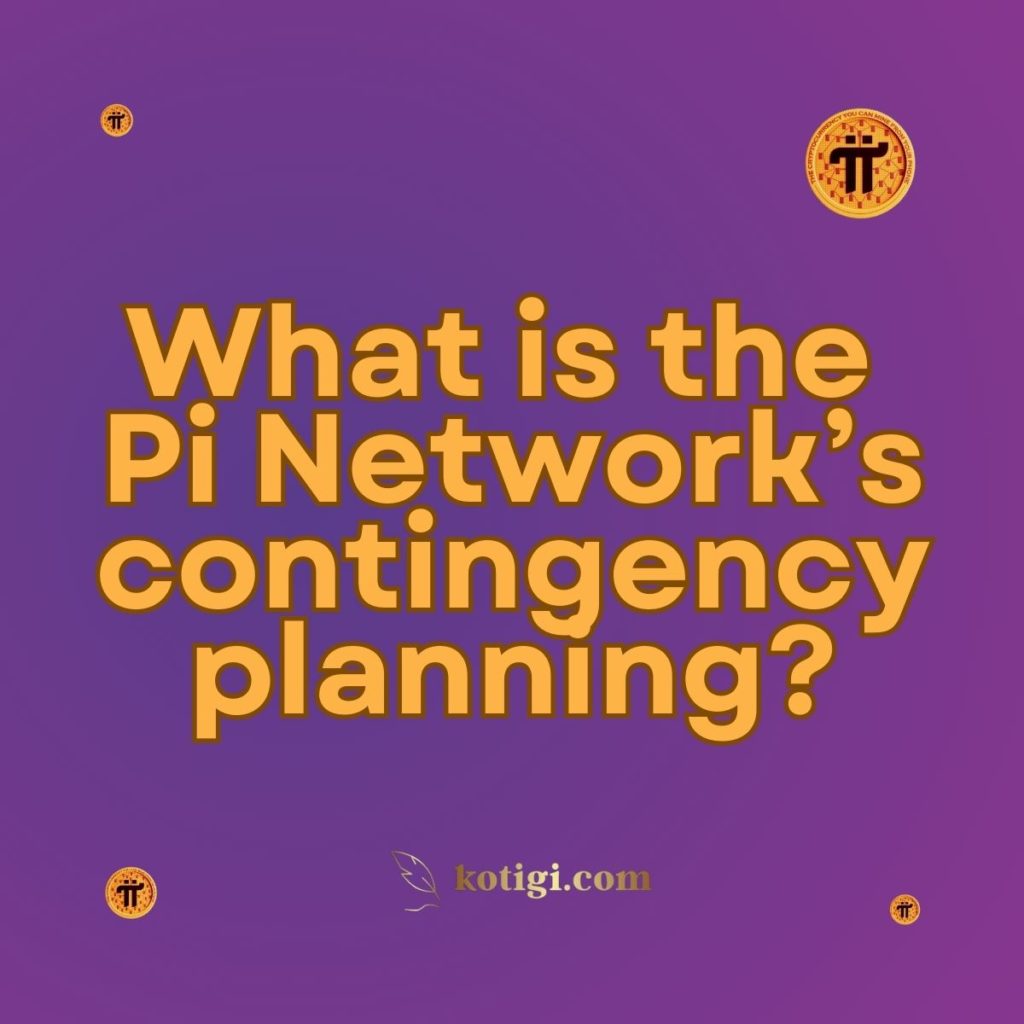
What is the Pi Network’s contingency planning?
Pi Network’s contingency planning is designed to prepare for unforeseen challenges by assessing risks, developing response strategies, and ensuring business continuity while maintaining user trust and network security.
Introduction
In the fast-paced world of cryptocurrency, where uncertainties and rapid changes are the norms, contingency planning has become an essential aspect of any project’s success. For Pi Network, which focuses on building a user-friendly, mobile-mining cryptocurrency platform, having a robust contingency plan is vital for managing potential disruptions. This post delves into the key elements of Pi Network’s contingency planning, including risk assessment, response strategies, communication protocols, recovery plans, and community engagement. Understanding these components helps users appreciate the platform’s resilience and commitment to maintaining operational stability.
Understanding Contingency Planning
Contingency planning involves preparing for unexpected events or emergencies that could adversely affect operations. It is a proactive approach that allows organizations to respond swiftly and effectively, minimizing disruptions and ensuring the safety of stakeholders. At its core, contingency planning is about anticipating potential crises and establishing a framework for action. This framework includes identifying risks, creating response plans, and ensuring that operations can continue even under adverse conditions.
Definition of Contingency Planning
At its essence, contingency planning refers to the strategies and processes developed to address unexpected disruptions. This involves analyzing potential crises and preparing actionable steps to manage those scenarios effectively.
Importance in the Cryptocurrency Sector
The cryptocurrency sector is characterized by volatility and regulatory uncertainty. Given the rapid evolution of technology and market dynamics, effective contingency planning is crucial for ensuring that platforms like Pi Network can adapt to changing conditions while safeguarding user interests and maintaining service continuity.
Key Objectives of Contingency Planning
The primary objectives of contingency planning include minimizing downtime, protecting user assets, ensuring effective communication, and maintaining trust in the platform. By focusing on these objectives, Pi Network can better navigate challenges and emerge stronger, ready to face whatever uncertainties the future may hold.
Risk Assessment and Identification
A crucial aspect of contingency planning is the identification and assessment of risks that may impact Pi Network. This process involves a thorough analysis of potential threats and vulnerabilities, providing a foundation for effective planning.
Identifying Potential Risks
Pi Network identifies various risks, such as security breaches, regulatory changes, market fluctuations, and technical failures. Understanding these risks is vital for developing effective response strategies that can be deployed swiftly when needed.
Evaluating Risk Impact and Likelihood
Once risks are identified, they are evaluated based on their potential impact on operations and the likelihood of occurrence. This assessment helps prioritize risks, ensuring that the most critical threats receive the necessary attention.
Continuous Monitoring of Risks
Risk assessment is not a one-time activity; it requires ongoing monitoring and reassessment. Pi Network continuously reviews its risk landscape to adapt to new threats and changing conditions, maintaining vigilance in an ever-evolving environment.
Documenting Risks and Findings
Maintaining a detailed record of identified risks, assessments, and mitigation efforts is crucial. This documentation serves as a valuable reference for future planning and decision-making, ensuring that lessons learned are not forgotten.
Developing Response Strategies
After assessing risks, Pi Network formulates tailored response strategies to address potential crises effectively. These strategies outline specific actions to take in various scenarios, ensuring that the team is prepared to act quickly when a situation arises.
Creating a Crisis Response Plan
Each identified risk has a dedicated crisis response plan that details the steps to take during an emergency, fostering a coordinated and efficient response. These plans are regularly updated to reflect new information and changes in the risk landscape.
Assigning Roles and Responsibilities
Clear roles and responsibilities are assigned to team members during a crisis, ensuring that everyone knows their specific tasks. This clarity facilitates a quick and organized response, reducing the chances of miscommunication or confusion.
Establishing Communication Protocols
Effective communication is crucial during crises. Pi Network develops protocols for informing users and stakeholders about the situation and the steps being taken to address it, ensuring that accurate information reaches all parties involved.
Testing and Refining Response Strategies
Regular testing and simulation of response strategies help identify weaknesses and improve the overall effectiveness of the contingency plan. Pi Network conducts drills to prepare its team for real-life scenarios, enabling them to respond effectively under pressure.
Communication Protocols During a Crisis
Communication plays a vital role in contingency planning. During a crisis, effective communication can make a significant difference in maintaining user trust and minimizing panic. Pi Network prioritizes transparent and timely communication with users to ensure they are informed and supported throughout the crisis.
Transparent User Updates
During a crisis, Pi Network commits to providing regular updates to users about the situation, including what caused the disruption and the steps being taken to resolve it. Transparency is key to maintaining user confidence and trust.
Utilizing Multiple Communication Channels
To reach users effectively, Pi Network leverages various communication channels, such as social media, official blog posts, email alerts, and community forums. This multi-channel approach ensures that users receive timely information, regardless of their preferred communication method.
Establishing a Crisis Communication Team
A dedicated crisis communication team is responsible for managing information dissemination during emergencies. This team ensures that communications are consistent and accurate, which is vital for preventing confusion and maintaining credibility.
Gathering User Feedback
Engaging with users during a crisis allows Pi Network to gather feedback and address concerns promptly. This two-way communication fosters a sense of community and support, reinforcing the relationship between Pi Network and its user base.
Recovery Plans and Business Continuity
A successful contingency plan includes recovery strategies that ensure the continuity of operations after a crisis. Pi Network has established a comprehensive business continuity plan designed to facilitate recovery in the event of disruptions.
Implementing Backup Systems
Robust backup systems are essential for protecting user data and maintaining platform functionality. Pi Network ensures that data is regularly backed up, allowing for a seamless transition in the event of an incident.
Establishing Recovery Protocols
Recovery protocols outline the steps needed to restore operations after a crisis. This includes identifying critical functions and ensuring that resources are allocated effectively to maintain those functions during recovery.
Conducting Post-Crisis Reviews
After resolving a crisis, Pi Network conducts thorough post-crisis reviews to assess the effectiveness of its response. This review process identifies areas for improvement and informs future planning, enhancing the overall resilience of the platform.
Continuous Improvement of Recovery Plans
Pi Network regularly updates its recovery plans based on lessons learned from previous crises and shifts in the operating environment. This ensures that the plans remain relevant and effective in safeguarding user interests, preparing the platform for future challenges.
Engaging the Community in Contingency Planning
Involving the community in contingency planning is crucial for fostering resilience and support during crises. Pi Network actively engages its users through various initiatives designed to build awareness and preparedness.
Educating Users on Crisis Preparedness
Pi Network emphasizes the importance of crisis preparedness by educating users about potential risks and encouraging them to take proactive measures to protect their assets. This education empowers users to respond effectively during emergencies.
Creating Community Support Networks
During crises, Pi Network encourages users to support one another through community forums and social media groups. This sense of solidarity helps users feel more secure and connected, enhancing the overall community spirit.
Gathering Community Input
Pi Network values community input in its contingency planning efforts. Gathering feedback from users helps refine strategies and ensures that their concerns are adequately addressed, fostering a sense of ownership among the user base.
Hosting Training Sessions
Pi Network organizes training sessions to educate users on how to respond during emergencies and navigate potential challenges effectively. This initiative empowers users with the knowledge and tools needed to handle crises confidently.
Conclusion
Pi Network’s contingency planning is a vital component of its overall risk management strategy. By conducting thorough risk assessments, developing tailored response strategies, and prioritizing effective communication, Pi Network demonstrates its commitment to safeguarding user interests and ensuring operational continuity. Engaging the community in this planning process further enhances the platform’s resilience, allowing Pi Network to thrive in an ever-changing cryptocurrency landscape. Through these efforts, Pi Network remains dedicated to providing a secure and reliable platform for its users, even in the face of unforeseen challenges.
Key Takeaways:
- Pi Network actively identifies and assesses potential risks to inform its contingency planning efforts.
- Each risk is paired with a dedicated crisis response plan that outlines specific actions to take during emergencies.
- Transparent communication with users is prioritized during crises to maintain trust and provide timely updates.
- Recovery plans include robust backup systems and protocols to ensure business continuity after disruptions.
- Community engagement is a key component of contingency planning, fostering resilience and support among users.





